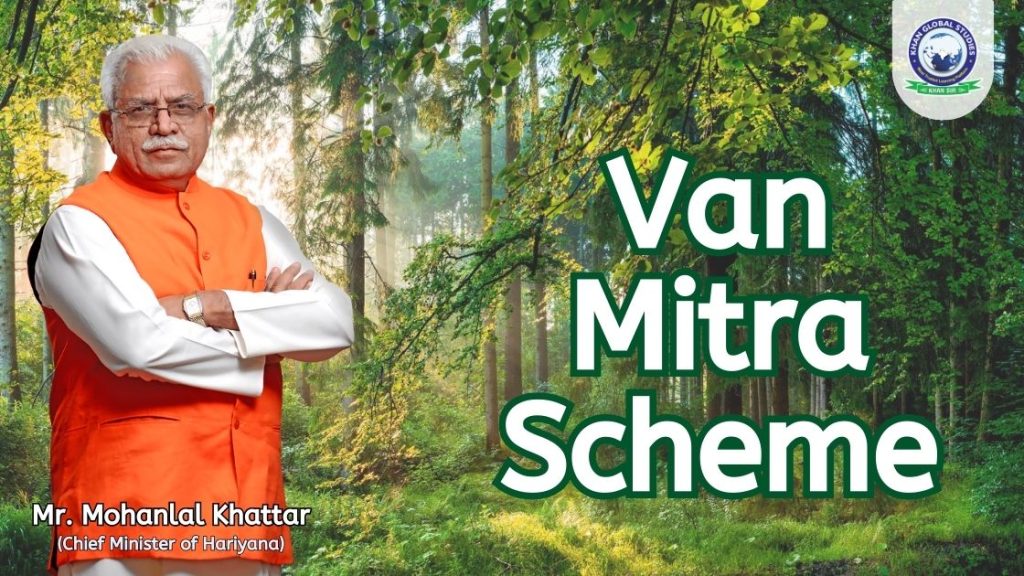The Van Mitra Scheme is a government initiative to encourage community participation in tree plantation activities on non-forest land. Recognizing the important role of green cover for a healthy environment and the scarcity of forest areas in Haryana, the scheme aims to directly involve local communities in increasing tree cover across the state. By leveraging the support of 7500 local volunteers from economically weaker sections, the scheme envisages promoting a culture of environmental stewardship and individual commitment towards tree planting and care.
Introduction
Environmental sustainability depends on the extent of green cover on land. In forest-deficit states like Haryana, there is a need to increase tree cover outside the designated forest areas for the restoration of ecological balance and ambient environment for the citizens. Van Mitra Scheme represents a strategic intervention aimed at mobilizing community resources and generating enthusiasm for tree plantation and post-plantation care.
Van Mitra Scheme Overview
Objective: To promote community participation in tree plantation, ensure an increase in the survival rate of plantations and increase tree cover on non-forest lands for a healthy living environment.
Operating Procedure
- Public Awareness: The scheme will be widely publicized through print and visual media and the website of the Forest Department.
- Identification of Eligible Families: Eligible families/individuals with annual incomes less than Rs 1.8 lakh will be identified from the family data. The Parivar Pehchan Patra (PPP) will be maintained by the Citizen Resource Information Department (CRID) and information about eligibility for participation in the scheme will be disseminated to households through various measures. Through this message, the stakeholders will be informed about the process of registration on the Van Mitra Portal/Mobile App of the plan.
- Registration: Eligible families will register one eligible family member (aged between 18 to 60 years) on the Van Mitra mobile app. Information about the number of saplings to be planted will be given by the family member at the time of registration, provided that the maximum is 1000 saplings. Among the registered applicants, priority will be given to low-income families and younger age applicants.
- Identification of land: Van Mitra will arrange land for tree plantation.
- Training: Van Mitras will be provided basic training on plantation techniques and safety measures. They will also be given practical training on the Van Mitra mobile app.
Technology Integration
- Van Mitra App: For registration, geo-tagging and survival assessment of plantations.
- Following the government’s Direct Transfer Benefit (DBT) policy, honorariums will be paid to Van Mitras directly into their accounts.
Basic Implementation Guidelines of the Scheme
- The saplings to be planted under the scheme will not be of short-lived species like eucalyptus and poplar, which are planted under agroforestry. Apart from this, only specific species of plants will be planted.
- The minimum distance from plant to plant will be eight meters.
- Van Mitras will select non-forest land for plantation anywhere in the village, town or city of their residence. If plantation has not been done on Van Mitra’s land, he will hand over the plants to the owner of the land on completion of four years of plantation and the owner will take care of the plants. his property. Honorarium of Rs. Van Mitras will be given Rs 25 per plant. If the tree planted is on Van Mitra’s land, he will be considered the owner of the tree and henceforth being the owner of the tree, further incentives will be admissible to him. An agreement will be signed between Van Mitra and the land owner that the owner will not cut the trees for at least 10 years. If the owner of the tree retains the tree till he attains the age of 75 years, the Government may consider paying an honorarium of an amount equal to the basic rate of Rs. 100 in the year 2024. Also, such trees will be recognized under the Pran Vayu Devta Scheme of the State Government and the guardians will get an admissible honorarium under the Pran Vayu Devta Scheme for the care of the tree.
Role and Responsibility of Van Mitra
- Identifying and arranging the land required for tree plantation. If Van Mitra does not own the land identified for tree plantation, he must obtain written permission from the owner.
- Digging the pits required for plantation and further planting the trees in the pits and taking care of them as per the specifications contained in the Standard Operating Procedures (SOP).
- To ensure good survival of plantations.
Role and Responsibility of the Forest Department
- To provide healthy saplings to forest friends for plantation.
- To provide basic training to Van Mitras on plantation techniques and its maintenance/protection and preparation of Standard Operating Procedures (SOP) like weeding, irrigation, frost protection measures etc.
- If necessary, forest guards, foresters and range officers will advise forest friends regarding tree plantation in their jurisdiction.
- Documentation of estimation of survival percentage of plantation done by Van Mitra.




Van mitar bharti Hui hai ya nahi